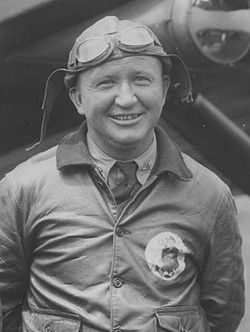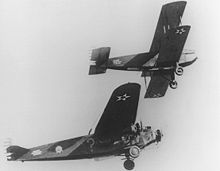- Odas Moon
-
Odas Moon 
Odas Moon in 1929Born c. 1892 Died November 19, 1937[1]
Old Point Comfort, VirginiaAllegiance  United States
United StatesService/branch  U.S. Army Air Service
U.S. Army Air Service
 U.S. Army Air Corps
U.S. Army Air CorpsYears of service 1917–1937 Rank  Major
MajorOdas Moon (ca. 1892 – November 19, 1937) was an American aviation pioneer who was among a team of United States Army Air Corps (USAAC) aviators to break endurance records by performing aerial refueling. Moon was a founding member of the Order of Daedalians.[2] Through his teaching and leadership at the Air Corps Tactical School, Moon helped shape and promote the concept of daylight precision bombing, using heavy bombers.
Contents
Early career
Along with many other United States Army Air Service fliers, Moon was assigned to fly patrols along the Mexico – United States border from May to September, 1919.[3] As part of his duties, Moon ferried a Mexican colonel back to Puerto Palomas, Chihuahua, Mexico.[4]
In January 1924, Moon was flying a delivery of mail to an American Army base in the Panama Canal Zone when he discovered an American invasion fleet lying in wait 125 miles (200 km) away from Panama. The fleet was made up of four battleships, a carrier and attendant vessels. Their plan was to surprise and "defeat" the defenders of Panama as part of annual winter maneuvers.[5] Moon was carrying a case of ripe tomatoes to give to his wife, and he proceeded to carry out a series of dive bombing attacks against the USS Langley, delivering three direct hits from tomato "bombs".[5] When he landed at the Panama base with the information that the fleet was coming, Moon was congratulated by his superiors. Soon, though, word was passed back regarding an unspoken goal of the surprise invasion fleet: they were there to prove that the Canal Zone needed a $10M purchase of 16-inch coastal defense guns. After the invasion fleet was discovered by an air unit while still 125 miles out, the need for coastal guns was no longer seen as urgent by Congress.[5] However, air defense doctrine was not re-examined as a result.[5]
In 1924 or 1925, Moon taught bombardment to new airmen at Kelly Field in Texas. Among his students was Charles Lindbergh who, in 1970,[6] wrote a letter to Senator Ralph Yarborough of Texas describing his memories of the foundational experience he was given by Moon.
Aerial refueling
As a trusted member of the 7th Bombardment Group, First Lieutenant Moon was selected to take part in the endurance demonstration flight of the Question Mark, a modified Atlantic-Fokker C-2A. During January 1–7, 1929, Moon piloted one of two aerial refueling aircraft, a Douglas C-1 based out of Van Nuys Airport,[7] and helped refuel the Question Mark as it flew for six days back and forth between San Diego and Van Nuys, California. Moon and his crew refueled the Question Mark sixteen times—two conducted at night.[8] The Question Mark set a world record for endurance.[9]
The USAAC followed up the flight of the Question Mark with a mission to demonstrate the applicability of aerial refueling in combat. On May 21, 1929, during annual maneuvers, Moon took off from Fairfield Air Depot in Dayton, Ohio in a Keystone LB-7 on a simulated mission to New York City via Washington, D.C. Plans were for the bomber to be refueled in flight several times, drop a flash bomb over New York harbor and a parachute flare over Atlantic City,[7] then return to Dayton non-stop, again by way of Washington. The C-1 tanker employed to refuel the LB-7 was forced by icing to land in Uniontown, Pennsylvania, where it got stuck in mud. After flying over Manhattan, Moon circled south to drop three flares in the harbor near the Statue of Liberty. Moon landed at Bolling Field.[10] The next day the tanker joined the bomber and both flew over New York where they made a public demonstration of air refueling and four dry runs.[11]
Order of Daedalians
Moon was a charter member of the Order of Daedalians, a group of former World War I-era military pilots who formed the organization on March 26, 1934. Under Harold L. George, Moon served as the first vice commander of the group.[2]
Bomber mafia
As a first lieutenant, Moon graduated from the class of 1930–1931 at the Air Corps Tactical School (ACTS).[12] From 1933 at the rank of captain until January 29, 1936, at the rank of major,[12] Moon was assigned to teach at ACTS. Moon challenged his students to thoroughly examine the bombardment theories he presented so they could discover any flaws. There, Moon joined Harold L. George, Eugene L. Eubank, Haywood S. Hansell and Ralph A. Snavely in arguing for the primacy of an independent bomber arm. Moon was vocal in his rebuttal of the arguments used by a group of ACTS teachers who were promoting fighters as the all-around useful aircraft that the USAAC should invest in. The fighter enthusiasts—Claire Chennault, Hoyt S. Vandenberg and Earle E. Partridge—argued that the fighter in large numbers was capable of doing more damage to ground targets than the number of bombers that could be bought for the same money. Moon and the so-called "Bomber mafia" tore the fighter argument apart and established precision bombing as the war-winning strategy.[13]
Death and legacy
Moon was relieved of duty at ACTS on January 29, 1936[12] and died at the age of 45 on November 19, 1937.[14] At the time of his death, Moon had been waiting in the Hotel Chamberlin, Old Point Comfort, Virginia to be retired from active service which was to have taken effect on December 31, 1937.[14]
Retired Air Force Major General Eugene L. Eubank said in a 1982 interview that Odas Moon, a very close friend of his, "drank himself to death".[15] Eubank said that he and "Odie" Moon had served in the Air Corps together from 1919 on the Mexico–U.S. border flights and had been devoted friends ever since.[15] Eubank served as Moon's copilot in May 1929 for the New York aerial refueling demonstration.[7]
During World War II, all of Moon's staff mates and commanders at ACTS went on to become influential general officers, as did all four officers on board the Question Mark and two of the officers flying with him in the tankers.[16]
All the crew members of the Question Mark were given Distinguished Flying Crosses, but none of the tanker crews were so honored.[16] Instead, Moon and the others received letters of commendation.[16] On May 26, 1976, the two surviving tanker crewmembers—retired brigadier generals Ross G. Hoyt and Joseph G. Hopkins—were awarded the DFC for their exceptional contributions to air-to-air refueling by Chief of Staff of the United States Air Force General David C. Jones.[16]
See also
References
- Notes
- ^ U.S. Army Register, p. 829. U.S. Government Printing Office, 1938
- ^ a b Order of Daedalians. About Us: "History of the Order of Daedalians". Retrieved on November 2, 2009.
- ^ Hinkle, Stacy C. Wings and saddles: the Air and Cavalry Punitive Expedition of 1919. University of Texas at El Paso. Southwestern Studies, Volume V, No. 3, Monograph Number 19. Editor: Samuel D. Myres. Texas Western Press, 1967, pp. 8, 11, 23.
- ^ Hinkle, Stacy C. Wings Over the Border: The Army Air Service Armed Patrol of the United States – Mexico Border 1919–1921. University of Texas at El Paso. Southwestern Studies, Monograph Number 26. Texas Western Press, 1970, pp. 21, 26.
- ^ a b c d Holley, I. B. Jr. (1975) "An Enduring Challenge: The Problem of Air Force Doctrine", within The Harmon memorial lectures in military history, 1959-1987: a collection of the first thirty Harmon lectures given at the United States Air Force Academy, edited by Harry R. Borowski. Diane Publishing, 1988, pp. 425–439. ISBN 0912799587
- ^ Heritage Auction Galleries. "Charles Lindbergh Typed Letter Signed". Retrieved on November 3, 2009.
- ^ a b c Maurer, Maurer. Aviation in the U.S. Army, 1919–1939, Part 301. United States Air Force, Office of Air Force History. Diane Publishing, 1987, pp. 244–245, 261–262. ISBN 0912799382
- ^ Smith, Seventy-Five Years of Inflight Refueling, p. 6.
- ^ Time Magazine, January 14, 1929. "Aeronautics: Question Mark." Retrieved on November 2, 2009.
- ^ Smith, p. 7.
- ^ Robert F. Adams (ed) (1997). Defenders of Liberty: 2nd Bombardment Group/Wing 1918–1993, Turner Publishing, Paducah, Kentucky, ISBN 1563112388.
- ^ a b c Finney, Robert T. (1998) Air Force History and Museums Program. History of the Air Corps Tactical School 1920–1940. Third imprint. Retrieved on November 3, 2009.
- ^ Moy, Timothy. War machines: transforming technologies in the U.S. military, 1920–1940, p. 66. Volume 71 of Texas A&M University military history series. Texas A&M University Press, 2001. ISBN 158544104X
- ^ a b The New York Times, November 21, 1937. Obituaries. "Captain Odas Moon; Army Air Corps Officer Was to Be Retired From Service on Dec. 31". Retrieved on November 3, 2009.
- ^ a b Eubank, Eugene L. U.S. Air Force Oral History Interview K239.0512-1345. Maj Gen Eugene L. Eubank. June 30 – July 1, 1982. Retrieved on November 14, 2009.
- ^ a b c d Airlift Tanker: History of U.S. Airlift and Tanker Forces, p. 53. Turner Publishing. 1995. ISBN 156311125X
- Bibliography
- Smith, Richard K. (1998). Seventy-Five Years of Inflight Refueling: Highlights 1923–1998 Air Force History and Museums, Air University, Maxwell AFB.
External links
Categories:- 1890s births
- 1937 deaths
- Aerial warfare pioneers
- American aviators
- Air Corps Tactical School alumni
- United States Army Air Forces officers
- United States Army Air Forces pilots
- Alcohol-related deaths in Virginia
Wikimedia Foundation. 2010.

